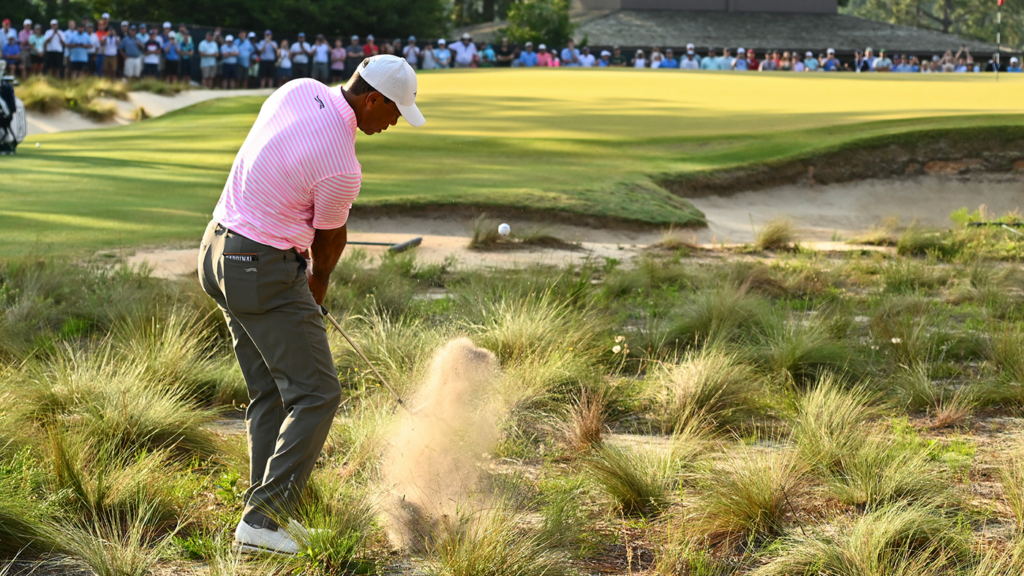PINEHURST, N.C. — Prior to the start of the 124th U.S. Open, only four golfers had broken par for the championship across the three times that Pinehurst No. 2 previously hosted the event. That brought out plenty of carnage-centric predictions ahead of this week’s fifth hosting with the national championship returning to the Sandhills of North Carolina. However, with 18 holes in the books, not only have we seen some low numbers, we’re seen three of the seven lowest scores ever played in Pinhurst-hosted U.S. Opens.
The co-leaders entering Friday, Rory McIlroy and Patrick Cantlay, tied Martin Kaymer’s record for the lowest score (65), which he achieved twice on the way to winning the 2014 U.S. Open. Ludvig Åberg’s 66 matched the mark recorded by both Daniel Berger (2014, fourth round) and Peter Hedblom (2005, second round).
So is Pinehurst No. 2, a course that has punished the world’s best golfers in U.S. Opens throughout the last 25 years, suddenly playing easier than anyone expected?
Donald Ross’ bowled green complexes with slick run offs and native areas creating unpredictable lies that throw golfers a curve ball. It demands creativity compared to some of the point-and-shoot tracks they see during the regular rotations. Holding greens on approach shots and then cleaning up your mess when you don’t is crucial to avoiding the big number, which — as Collin Morikawa can tell you — can throw a wrench into an otherwise solid round of championship golf.
65
Rory McIlroy
2024 | 1st
—
65
Patrick Cantlay
2024 | 1st
—
65
65
Martin Kaymer
2014 | 1st
2014 | 2nd
Won
66
Ludvig Åberg
2024 | 1st
—
66
Daniel Berger
2014 | 4th
T28
66
Peter Hedblom
2005 | 2nd
T11
Morikawa played 16 holes at 4 under on Thursday, but double-bogeys at both the par-3 9th and the par-3 15th left him at even par for the tournament.
“I don’t think there’s a lot of you can label as ‘screaming birdie opportunities,’ but from 20 feet, you’re able to make a lot of putts and if you give yourself an uphill putt,” Morikawa explained. “The doubles hurt. I wanted to minimize as many bogeys and doubles as possible. … I think the amount of birdies I made shows that I can still shoot a low score.”
Morikawa echoed what many described throughout the day: There is a formula to giving yourself chances to score. It’s a defensive style, one that McIlroy described as “conservative.” But if the focus is on holding greens (McIlroy hit 15 of 18 greens in regulation), one will end up with more birdie putts than he otherwise would paying the run-off penalties that can accompany more aggressive attacks at some downright diabolical pin locations.
McIlroy also acknowledged there was a bit of luck in his record-tying round; he got lucky that his distances into the greens were “good numbers” that allowed him to take full swings. He also believes that the entire afternoon wave was fortunate that cloud cover and mid-summer humidity kept the greens from really baking out and firming up.
Pinehurst as a whole played more than three strokes over par — eight strokes behind the leaders. And while there are 15 golfers under par after Round 1, only eight of them are 2 under or better.
One sees those low, record-tying numbers atop of the leaderboard and wonder whether the U.S. Open has gotten soft, but that’s a mistake. It’s the individuals that are the anomalies, not the course conditions at Pinehurst No. 2.
If scores are basically the same Friday, the projected cutline will likely hover around 4 over. And while Kaymer was running away with the 2014 U.S. Open with a pair of 65s in the first two rounds, Pinehurst No. 2 was cooking the rest of the field with a cut at 6 over.
Pinehurst is not a course with a cheat code but rather a dress code of which one must abide. If golfers can meet the standard for what No. 2 asks, they can find success that seemingly few in the field are achieving.
Will this tournament will get more teeth in response to these lucky few low scores? McIlroy pointed to the conditions as a benefit for his successful afternoon, but Cantlay credited favorable weather as a reason for his low score in the morning wave.
Cantlay, who has a top-10 finish in every major except the U.S. Open, is wary off how play will progress in terms of both the weather and the set up. He suggested playing early Thursday with no wind would perhaps be “the easiest [the course] will play all week.” But he doesn’t imagine that will necessarily continue, at least if the USGA chooses to let things firm up heading into the weekend.
“With the weather cooperating, it being warm, I imagine they can get the golf course as difficult as they want. With the Bermuda greens and no rain in the forecast, I expect the golf course to play very difficult in the next few days,” he said.
If you’re a golf fan who wants the U.S. Open to be carnage, if you want to see golfers struggle to score the way weekend warriors do, you are certainly rooting for the course to bite back at the leaders. But the sample size of all 156 competitors suggests this is still a difficult edition of the U.S. Open, and perhaps regression to the mean is in order for those lucky few who were able to go low on the championship’s first day.
Rick Gehman, Patrick McDonald and Greg DuCharme recap the opening round of the 2024 U.S. Open at Pinehurst No. 2. Follow & listen to The First Cut on Apple Podcasts and Spotify.
>>> Read full article>>>
Copyright for syndicated content belongs to the linked Source : CBS Sports – https://www.cbssports.com/golf/news/2024-u-s-open-despite-record-low-scores-pinehurst-no-2-is-playing-tough-and-may-get-even-more-arduous/
